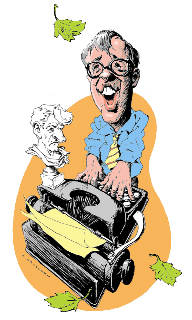Never let it be said of your doting correspondent, that he flinched from undergoing the tortures of Hades on behalf of the edification and uplift of his loyal readers. He did just that last Sunday afternoon, in fact, forsaking domestic comforts and bright sunshine to join the paltry crowds at the scene of that notorious crime, the Music Center Opera’s current production of Offenbach’s “Orpheus in the Underworld.”
Why? News was out that Dom DeLuise, whose casting in the role of Public Opinion had been the major flaw in the production on opening night, had been replaced, at least temporarily, by one Roderick Cook. That {ITAL had {ENDITAL to be an improvement worth checking out. Besides, despite what you think, no critic worth his word processor gets that much pleasure out of running his verbal bulldozer over honest human effort. Perhaps I was out of sorts that first night; perhaps {ITAL they {ENDITAL were.
Sorry, no such luck. Mr. Cook, best known as the author and star of “Oh, Coward,” at least makes the effort to take aim at some of Offenbach’s music, and often comes within hailing distance of the right pitch. But his prissy-Brit mannerisms have no more to do with his part — the crucial role in the whole work, I remind you, the character who stands in for the librettists’ and Offenbach’s visions as they skewed the ancient legend around to fit the tastes of Belle-Epoque Paris — than Dom DeLuise’s epic vulgarity.
Whatever he might have accomplished on his own, Mr. Cook must play along with all the {ITALshtik {ENDITAL that designer Gerald Scarfe and director Peter Schifter have contrived for the role. Worst of all is that ugly, bloated, stage-filling bustle-shaped conveyance on which he must ride.
There was, in fact, one definite change for the better at Sunday’s performance, David Eisler (remember? Candide?) as Pluto, with his clean young-sounding tenor and his superior diction replacing the nanny-goat squalling of Ronald Stevens, who was reported as ailing. Grateful we must be for such small favors; yet nothing can save this misbegotten misrepresention, over-all, of the Offenbach genius.
Once again, however, the glorious moment of Michael Smith’s Act-2 entrance as Mercury, done up in silver and truly mercurial, contained the concentrated energy, dash and immense good humor that the show otherwise lacked. I would suggest to management, in fact, that Mr. Smith and his all-but-airborne performance be preserved and inserted into all operas from now on, whenever affairs on stage seem without hope.
I neglected to mention the rest of the dancing in my first review; after my second visit I remembered why. They can can that can-can.
-

-
Categories
-
-
Archives
- April 2010
- February 2010
- December 2009
- November 2009
- October 2009
- September 2009
- June 2009
- May 2009
- April 2009
- March 2009
- February 2009
- January 2009
- December 2008
- November 2008
- October 2008
- September 2008
- August 2008
- July 2008
- June 2008
- May 2008
- April 2008
- March 2008
- February 2008
- January 2008
- December 2007
- November 2007
- October 2007
- September 2007
- August 2007
- July 2007
- June 2007
- May 2007
- April 2007
- March 2007
- February 2007
- January 2007
- December 2006
- November 2006
- October 2006
- September 2006
- August 2006
- July 2006
- June 2006
- May 2006
- April 2006
- March 2006
- February 2006
- January 2006
- December 2005
- November 2005
- October 2005
- September 2005
- August 2005
- July 2005
- June 2005
- May 2005
- April 2005
- March 2005
- February 2005
- January 2005
- November 2004
- October 2004
- September 2004
- August 2004
- July 2004
- June 2004
- May 2004
- April 2004
- March 2004
- February 2004
- January 2004
- December 2003
- November 2003
- October 2003
- September 2003
- August 2003
- July 2003
- June 2003
- May 2003
- April 2003
- March 2003
- February 2003
- January 2003
- December 2002
- November 2002
- October 2002
- September 2002
- August 2002
- July 2002
- June 2002
- May 2002
- April 2002
- March 2002
- February 2002
- January 2002
- December 2001
- November 2001
- October 2001
- September 2001
- August 2001
- July 2001
- June 2001
- May 2001
- April 2001
- March 2001
- February 2001
- January 2001
- December 2000
- November 2000
- October 2000
- September 2000
- August 2000
- July 2000
- June 2000
- May 2000
- April 2000
- March 2000
- February 2000
- January 2000
- December 1999
- November 1999
- October 1999
- September 1999
- August 1999
- July 1999
- June 1999
- May 1999
- April 1999
- March 1999
- February 1999
- January 1999
- December 1998
- November 1998
- October 1998
- September 1998
- August 1998
- July 1998
- June 1998
- May 1998
- April 1998
- March 1998
- February 1998
- January 1998
- March 1992
- February 1992
- January 1992
- December 1991
- November 1991
- October 1991
- September 1991
- August 1991
- July 1991
- June 1991
- May 1991
- April 1991
- March 1991
- February 1991
- January 1991
- December 1990
- November 1990
- October 1990
- September 1990
- August 1990
- July 1990
- June 1990
- April 1990
- January 1990
- July 1989
- June 1989
- May 1989
- April 1989
- March 1989
- February 1989
- January 1989
- January 1983
-

Alan's Poppies and Sage, photographed by Paul Cabanis, Spring 2010.


